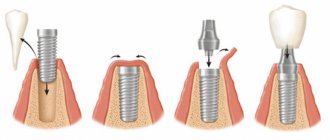Alveolitis is an inflammation of the socket (alveoli) left after tooth extraction. This pathology does not always develop; its development depends on many factors. The disease is characterized by severe pain in the area of the hole formed after surgery, general weakness, fever, headache, enlarged submandibular lymph nodes, bad breath and other unpleasant symptoms.
Alveolitis is not only physically painful, but also a dangerous disease. In the absence of proper treatment for several days, the inflammatory process can result in limited osteomyelitis, purulent melting of the jaw bone, and then surgical intervention will be required again.
With timely diagnosis of pathology and proper sanitation of the socket, the treatment prognosis is favorable. The main thing is to detect the symptoms of the disease in time and begin to treat it.
Content:
- When white plaque is the norm
- When white plaque is a harbinger of disease
- Why do complications occur after tooth extraction?
- How to recognize the problem
- Diagnostic measures
- Treatment of alveolitis
After tooth extraction, it is important to monitor the condition of the mucous membrane.
Very often a white coating appears in the extraction area. It frightens patients because it seems something strange to them, and to some it resembles an accumulation of purulent masses. It should be noted that white plaque in the socket after tooth extraction can be either normal or a complication. In the first case we are talking about natural regeneration, in the second - about alveolitis.
Prevention
The best prevention of pathology after tooth extraction is to be attentive to yourself and follow all the surgeon’s recommendations. While the hole is healing, give up bad habits, eating too hot, spicy, sweet foods, and if possible, switch to pureed foods. And if you suspect inflammation, contact your dentist as soon as possible.
Under no circumstances should the first symptoms of alveolitis be ignored. Against the background of inflammation, more serious problems may arise:
- Phlegmon is an acute diffuse purulent inflammation.
- An abscess is a purulent inflammation of tissues with their melting.
- Osteomyelitis is a purulent-necrotic process that can develop in the bone and bone marrow, as well as in the surrounding soft tissues.
- Periostitis is inflammation of the periosteum.
- Sepsis is a severe systemic inflammatory reaction.
- Tissue necrosis is local tissue death.
Modern methods of treating alveolitis make it possible to quickly relieve the symptoms of inflammation and avoid the complex consequences of the disease. The sooner the patient consults a doctor, the less likely it is to develop complications.
When white plaque is the norm
Nature intended it so that damaged tissues should be protected from the penetration of infectious agents. This is why, after a tooth is removed, a clot and white plaque forms in the socket. The latter is nothing more than fibrin, a protein needed for blood clotting. It protects the wound surface from infection and does not allow the inflammatory process to spread.
At first, the white film seems very thin, but gradually it turns into bone tissue. Some even mistake plaque for food debris and try to remove it with their tongue or using foreign objects. Under no circumstances should this be done. If the wound heals according to plan, there are no severe pain symptoms, there is no need to worry or touch it. This can lead to complications.
So, fibrin in the form of a whitish coating is needed to:
- the wound healed quickly;
- no infection penetrated into the socket;
- soft tissues were not inflamed.
If the patient has questions regarding the white clot on the surface of the damaged gum, he should consult with his dentist. You don't need to do anything yourself.
Conclusions: what does white plaque in the area of tooth extraction indicate?
In most cases, as it turned out, white plaque on the gums in the area of tooth extraction is a physiological process, it indicates normal healing of the wound. This is a fibrin protein that protects the wound from infection. Therefore, under no circumstances should you remove plaque, try to pick it out or spit it out.
- Gums turned white after tooth extraction
No need to disturb the hole
If a white plaque appears that does not go away for a long time, swelling is observed at the removal site, and pain persists for more than two days, complications may have arisen. See a doctor and make sure that there are no pathological healing processes in the hole.
Wisdom tooth removal requires a longer recovery period. Immediately after the procedure, the doctor will tell you what to take, how to treat sutures (if you need to do this), how to behave, etc. Be attentive to your health! Tooth hurts, what to do, read the article for details.
When white plaque is a harbinger of disease
It also happens that a whitish coating indicates the development of alveolitis after tooth extraction. This means that the tooth socket has become infected. In this condition, the patient is concerned about:
- severe pain in the area of the removed unit;
- increased body temperature;
- weakness, decreased performance;
- enlargement of the submandibular lymph nodes;
- headache;
- unpleasant putrid odor from the mouth and the same taste in the mouth.
If you experience these symptoms, you should make an appointment at the dental clinic as soon as possible.
Causes of the disease
The development of the disease can be caused by many reasons, from violation of the treatment regimen to serious pathologies. The most common factors:
- Excessively frequent mouth rinsing. Causes blood to be washed out of the socket, facilitating the penetration of bacteria there;
- The entry of food into the hole, which, if cleaned poorly, causes an inflammatory process;
- Low immunity, lack of vitamins, minerals and trace elements in the body;
- Complications after surgery;
- During the operation, oral hygiene was poor; dental plaque got there and was not removed.
Symptoms
The first and main sign of the disease is that the socket in place of the extracted tooth does not heal. If blood constantly oozes out at the removal site, then the formation of a protective blood clot is disrupted and the situation needs to be corrected. Remember, an open wound is not protected from bacteria, so unwanted inflammation can begin there at any moment. When this process occurs, purulent discharge and bad breath appear. It is important not to self-medicate, but to consult a doctor to adjust treatment.
Why do complications occur after tooth extraction?
The most common reason for the development of complications is the patient’s failure to comply with medical prescriptions. Normally, the hole should heal within a few days. She shouldn't be sick for a long time. As a result of the fact that the blood clot closes it, it is reliably protected from viruses and food debris.
It happens that a person actively rinses the wound or constantly touches it with his tongue, fingers, and tries to remove the light coating. Then the clot displaces or does not form completely, the tissue becomes infected and alveolitis develops.
Untreated neighboring teeth can also lead to disease (which is why all carious “cavities” need to be treated before removal), and failure to comply with the rules of oral hygiene. If you properly prepare for extraction and follow all the doctor’s instructions, the risk of developing alveolitis after removal will be minimal.
How to recognize the problem
How to understand that white plaque signals a problem?
If the gums heal well, then within 2-3 days after surgery the pain becomes very weak and barely noticeable. The wound closes with a dense clot and practically does not bother the person. With the development of alveolitis on days 3-5, the pain, on the contrary, intensifies. It's pulsating. It can become unbearable. Sometimes it radiates to the entire half of the face. Body temperature rises, lymph nodes enlarge, appetite decreases, salivation becomes stronger. The face may also become swollen.
In such a situation, staying at home is dangerous - inflammation can spread to the deep tissues of the jaw. You need to immediately go to the dental clinic.
Treatment of alveolitis
If alveolitis occurs after tooth extraction, you need to undergo dental treatment aimed at:
- elimination of the infectious focus;
- preventing possible complications;
- maintaining the integrity of the rest of the dentition.
First, the dentist cleans the socket and rinses it. It is important to wash away all purulent masses and dead tissue from it. Antiseptics and hydrogen peroxide work well for this purpose.
To reduce painful symptoms, which deprive the patient of the opportunity to fully rest and work, analgesics are used. It is better to use them by applying applications. Compresses are changed every half hour. It is also possible to take drugs orally, that is, in the form of painkillers and anti-inflammatory tablets.
If the patient has concomitant diseases or reduced immunity, the doctor may decide to prescribe antibiotics. They quickly relieve inflammation and speed up the healing of damaged tissue.
If you seek qualified dental care in a timely manner, the prognosis for alveolitis is favorable. After 3-5 days, the symptoms begin to subside, and the person’s well-being improves. Residual socket pain may persist for another 2-3 weeks, but it does not pose a threat.
Tooth extraction itself is an unpleasant procedure. And if complications arise, such as alveolitis, then the patient’s mood deteriorates even more. In order to prevent its occurrence, you need to know everything about this unpleasant disease. We will tell you what you need to know about the causes of alveolitis, its types, first symptoms and treatment methods.
What it is
Alveolitis of the tooth socket is an inflammatory disease that occurs after tooth extraction as a result of infection of the wound. If the operation was difficult, with injury to the gums and the tooth socket itself, then the risk of complications increases significantly. Normally, the hole after tooth extraction heals within one to two weeks, but with alveolitis this process takes a long time.
Since the disease occurs when an infection enters the wound, in order to prevent complications from occurring, it is necessary to carefully monitor oral hygiene after the tooth extraction procedure.
Alveolitis can occur before the tooth extraction procedure as a result of infection.
Causes
Alveolitis of the socket most often occurs after tooth extraction and is considered its main complication. However, it does not always occur. In order for this complication to arise, a confluence of certain circumstances is necessary.
The main causes of alveolitis are:
- destruction of the blood clot that forms after tooth extraction and prevents infection from entering the wound;
- getting plaque, stone, or bone fragments into the hole during removal;
- unscrupulous cleansing of the hole by a doctor from granulomas and granulations;
- violation of sterility during surgery;
- too traumatic removal;
- failure on the part of the patient to comply with all the doctor’s instructions;
- reduced immunity and exhaustion of the patient’s body.
After tooth extraction, you should not rinse your mouth too vigorously, as you can wash out the formed blood clot from the hole; this threatens the entry of pathogenic microbes into the wound, which cause inflammation.
Symptoms
The first signs of alveolitis usually appear 2-3 days after the procedure. The symptoms of the disease cannot be confused with anything. This is, first of all:
- severe pain in the area of the extracted tooth;
- constant intensification and spread of pain to adjacent areas of the oral cavity;
- fever up to 38.5° C, chills and general deterioration of health;
- the appearance of bad breath;
- inflammation, swelling and redness of the gums;
- absence of blood clot;
- the presence of a specific gray plaque;
- enlargement of the submandibular lymph nodes;
- presence of purulent exudate.
If one or more symptoms of the disease appear, you must immediately consult a dentist, since alveolitis does not go away on its own, it must be treated as soon as possible. Otherwise, complications are possible.
Diagnostics
The diagnosis of “alveolitis” can only be made by a doctor after a thorough examination of the patient’s oral cavity. Do not self-diagnose under any circumstances! This is a serious disease that, without proper treatment, can cause more dangerous complications, including blood poisoning. The absence of a blood clot in the socket at the site of the extracted tooth in the presence of other symptoms of the disease is decisive when making a diagnosis.
Treatment
If treatment for alveolitis is started in time, the disease usually goes away within a few days. Treatment usually consists of the following:
- thorough removal under local anesthesia of the remaining blood clot at the site of the extracted tooth;
- treating the walls of the socket with a dental instrument until slight bleeding appears;
- further treatment with a special antiseptic raster to prevent the spread of infection;
- the use of antibiotics (usually in the form of a powder that is sprinkled on the hole);
- prescription of painkillers;
- rinsing the mouth with antiseptic solutions;
- physiotherapeutic procedures aimed at speedy healing of the wound.
One of the most common complications of alveolitis, if not treated promptly, is osteomyelitis of the jaw bone. To prevent its occurrence, you should immediately consult a doctor as soon as you suspect some signs of alveolitis.
If you do not have the opportunity to see a dentist immediately, before visiting a doctor you should rinse your mouth with a warm (but not hot!) 3% solution of hydrogen peroxide or baking soda (half a teaspoon of soda per glass of boiled water).
Medicines
After thoroughly treating the hole, the doctor usually prescribes special medications to the patient for the treatment of alveolitis. In addition to antibiotics and painkillers, antiseptic solutions for oral baths and mouth rinses are necessarily prescribed, because maintaining the cleanliness of the mouth and socket is an indispensable condition for successful treatment.
The following drugs are most effective:
- Hexicon . A modern antiseptic drug that is successfully used in dentistry. Particularly effective for stomatitis, gingivitis, periodontitis, alveolitis. Intended for topical use. Hexicon solution is used both in the form of applications and in the form of oral baths or for rinsing the mouth.
- Corsodil . The active substance of the drug is chlorhexidine. This is an effective antiseptic that has a bactericidal effect. Used in dentistry to disinfect the oral cavity. Used externally, as a solution for rinsing, irrigation and applications. After cleaning the socket of an extracted tooth, systematically rinsing the mouth with Corsodil solution has a good effect.
- Stomatidin . An effective antiseptic with antifungal and antibacterial spectrum, which is used not only in dentistry, but also in ENT practice. It prevents the development of infections and is indicated for stomatitis, gingivitis, alveolitis, periodontal disease, tonsillitis and pharyngitis. It is used both for rinsing the mouth and for applications.
- Chlorhexidine . A proven broad-spectrum antiseptic drug that is used for disinfection not only in dentistry. Effective for treating purulent wounds, in the treatment of diseases of the oral mucosa. It is an excellent preventative against most dental diseases.
- Eludril . Created on the basis of chlorhexidine. It has analgesic, anti-inflammatory and antiseptic effects. Indicated for stomatitis, gingivitis, alveolitis, periodontitis, as well as for treating the oral cavity before and after tooth extraction.
Prevention
The best prevention is the patient's strict compliance with all doctor's instructions. After tooth extraction, you should not rinse your mouth too aggressively to avoid damaging the blood clot. After all, its presence in the socket is a guarantee that pathogenic bacteria that provoke inflammation of the socket or alveolitis will not get into the wound.










